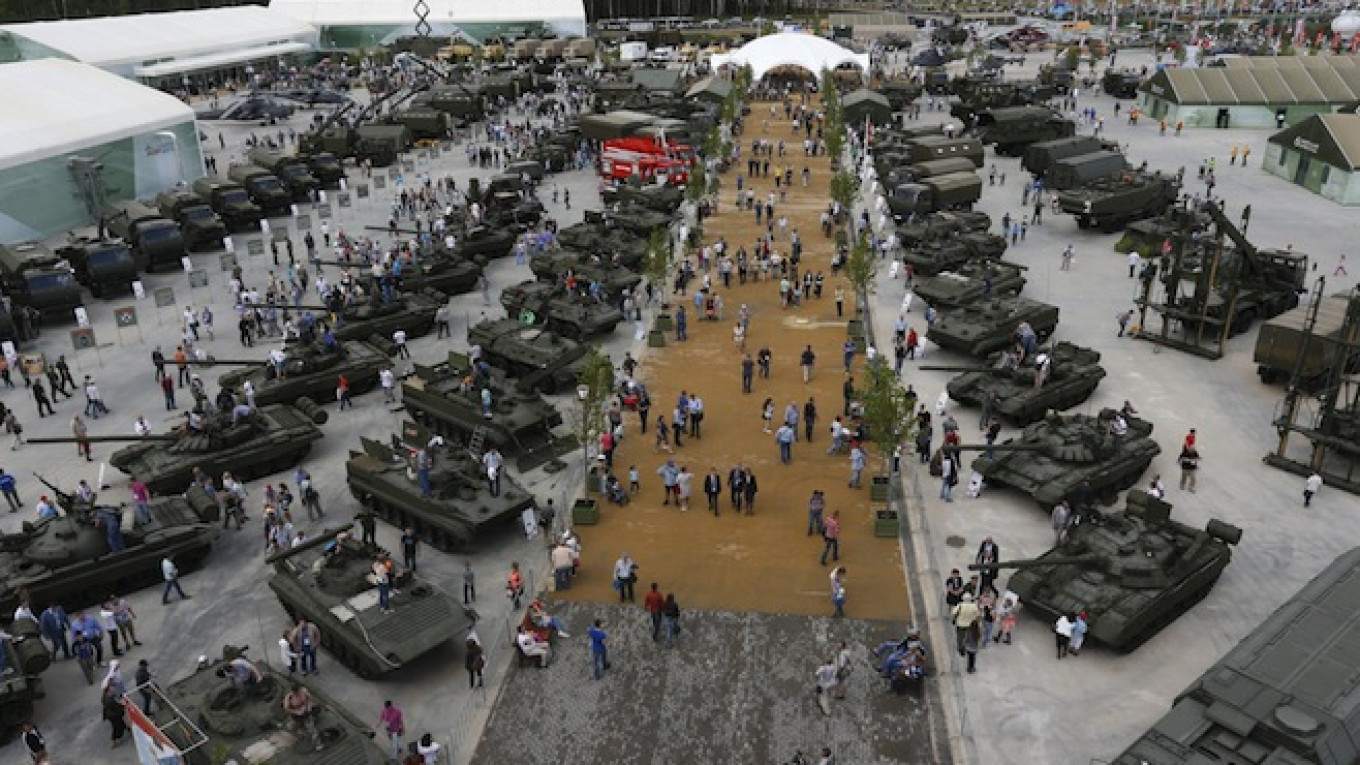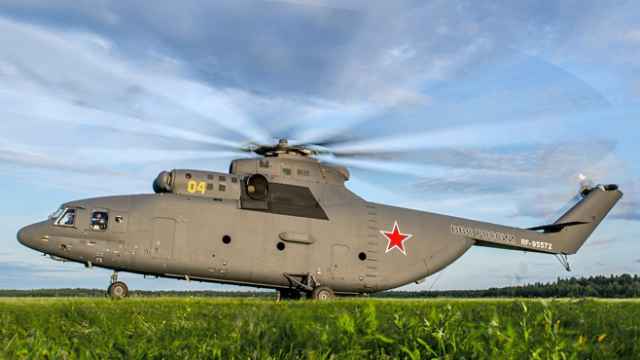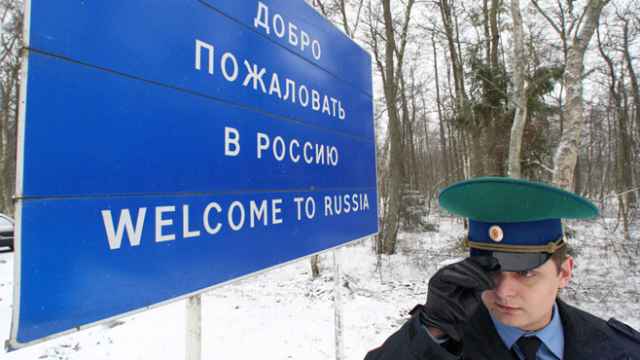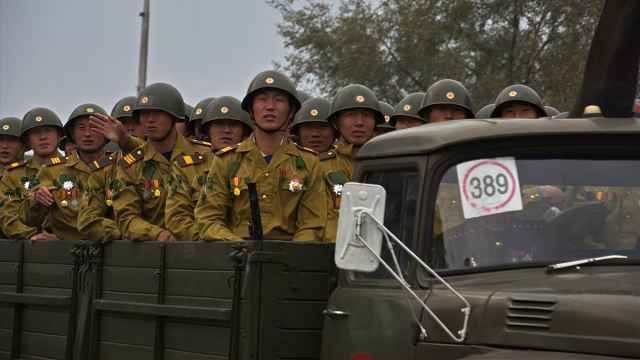Russia's economic crisis is forcing the government to trim its prized defense budget, and if the situation worsens, President Vladimir Putin may have to choose between his current saber-rattling and buying the new equipment his Soviet-style forces have been promised.
Back in 2011, when relations with the West were relatively tranquil and Russia's shows of force less frequent, Putin pledged to carry out a massive rearmament campaign with 20 trillion rubles ($370 billion) dedicated to buying new military hardware through 2020.
The program on average consumes around two-thirds of Russia's annual defense budget, and Putin has said this money will go toward replacing 70 percent of the military's aging Soviet-era hardware with top of the line gear by the end of this decade.
But with Russia's economy forecast to shrink by around 3 percent this year, the 2015 defense budget has been reduced by about 5 percent to 3.1 trillion rubles ($57 billion).
This will force the Defense Ministry to choose which costs it cuts. If Putin's rearmament drive continues to be the main spending priority, as official statements suggest, “[the Defense Ministry] is likely to have to divert funding from other areas of defense expenditure,” Crag Caffrey, a senior budget analyst at international defense consultancy IHS, said in a note this week.
According to Caffrey, the most likely source of savings will be cuts to the operations budget — which funds, among other things, the massive military exercises and bomber patrols that have riled up members of the NATO military alliance over the past 18 months.
In other words, if Russia wants to build a modern military to deter what it sees as an encroaching threat from NATO's expansion, it may be forced to cut back on exercises designed to present its military as a viable force right now.
Defense Budget Still Rising
Doubts that Russia can afford to modernize its conventional forces as planned have been bolstered by a reduction in overall defense spending for the year, which Deputy Defense Minister Tatyana Shevtsova — the ministry's head of finance — said in January would amount to a 10 percent cut.
This may have been an overestimate: data published by IHS this week show that this year's budget has been cut by only 5.3 percent to 3.1 billion rubles ($57 million), which is still a 25 percent increase in military spending compared to 2014.
With the budget contracting, the next question is: what gets cut? Officials ranging from Putin to Shevtsova have stated repeatedly that the state rearmament program will not be touched.
In effect, this means that “the share of the budget that is dedicated to [the rearmament program] will have to increase, and this could lead to [...] cuts in personnel and operational spending,” Caffrey told The Moscow Times.
Hit to Operations
Spending cuts will wreak havoc on the military's training exercises and ability to use the new equipment it receives, according to Siemon Wezeman, a senior researcher at the Stockholm International Peace Research Institute.
“Basically, the Russian forces would get a whole lot of new equipment from the [rearmament program], but a whole lot less money to operate [both] the old and new equipment,” Wezeman said.
This would be a serious problem for the various branches of the armed forces already receiving and learning to use new vehicles and equipment, such as the Russian navy.
The navy has received a handful of new nuclear-powered submarines over the last two years, which in part accounts for a significant rise in naval training exercises and operations.
Naval chief Admiral Viktor Chirkov said Wednesday that the number of nuclear submarine patrols has increased 50 percent since 2013, the TASS news agency reported. The number of total training exercise has also risen 20 percent since January 2014, he said.
Hard Choices
Nuclear submarine patrols are critical to Russia's nuclear deterrence, which is itself the foundation of Moscow's claim to military superpower status. But economic pressure may soon force Moscow to choose between training sailors to use this equipment and continuing the current displays of military might that have raised hackles in NATO.
According to Wezemen, continuing to fund “some of the more 'assertive' operations,” such as Tu-95 bomber flights along NATO airspace and massive surprise exercises near Europe, would require Russia “taking even more funds away from normal training operations or [allocating] some 'emergency' funding.”
Caffrey sees the choice as less drastic. Because of the overall increase in defense spending this year, Russia will be able to sustain its current levels of operational activity in the near term — but not more, he told The Moscow Times.
“In light of the current tensions with NATO, Russia is likely to continue to send out patrols and test NATO responses and conduct extensive exercises, but we wouldn't expect a major uptick in this kind of activity over the remainder of the decade,” Caffrey said.
Demands Rising
But even if Russia can save its 2015 rearmament plans by cutting aspects of its operations budget, the Defense Ministry has to start raising its annual procurement budget drastically if it is going to meet the rearmament program's goals over the coming years.
According to Caffrey, in order to hit Putin's 20 trillion rubles ($370 billion) spending target by 2020, the Defense Ministry will need to increase its procurement budget by 10 percent annually beginning next year.
“While the large budget increase in 2015 should see the [state defense order] remain on track in the short term, it remains to be seen whether the growth can be sustained,” he said. This year's defense procurement budget is almost 2 trillion rubles ($37 billion).
Even if Russia can manage to sustain 10 percent annual growth of its procurement budget, Defense Ministry officials have signaled that it still may not be enough to afford the vast quantities of new hardware envisioned by the program.
Problems Down the Road
Because of last year's ruble devaluation, military hardware is now more expensive to produce than it was in 2011, when the rearmament program was approved, said Ruslan Pukhov, head of the Moscow-based Center for the Analysis of Strategies and Technologies, a defense think tank.
The ruble fell about 40 percent against the U.S. dollar in 2014 under pressure from steep falls in the price of oil, Russia's chief export commodity.
In March, Deputy Defense Minister Yury Borisov said the Defense Ministry would have to curtail its orders for some of the defense industry's flagship vehicles, including the Sukhoi T-50 stealth fighter and Armata T-15 main battle tanks.
Instead of buying 52 T-50 fighters — Russia's answer to the U.S. F-22 stealth fighter — the Defense Ministry will now purchase only 12 of them to start, Borisov was quoted by the Kommersant newspaper as saying. The air force will evaluate their performance and then decide how many they can afford, Borisov said.
Orders of the Armata tank will likely face delays as well. Putin has said that the Defense Ministry will buy 2,300 of the tanks by 2020, but Borisov told newspaper Moksovsky Komsomolets in March that Armata turned out to be far more expensive than anticipated.
Armata's price tag isn't publicly known, but it has been estimated in the Russian and international press to cost around $7 million a unit.
Nuclear Priority
If the Defense Ministry is forced to slash purchases of new equipment, it will most likely cut procurements for its conventional, rather than nuclear, forces.
Borisov said previously that the Defense Ministry could not delay construction of nuclear submarines for the navy, but that orders of Armata tanks could wait. In the context of Russia's nuclear-dependent national security strategy, submarines outweigh tanks or fighter jets.
Further underscoring Russia's priorities, Putin turned heads in the West this week by announcing that the Russian military would receive 40 nuclear missiles by the end of the year.
The Borei-class nuclear submarine Alexander Nevsky last month received its full complement of 16 new Bulava nuclear missiles. It is not clear whether the 16 submarine missiles were included in the 40 cited by Putin, but when the president spoke about modernizing the nuclear forces in December, he said 2015 would see more than 50 new missiles enter service.
Russia has been putting an average of 40 new nuclear missiles into service annually for the past several years, according to the Bulletin of Atomic Scientists — and shows no sign of stopping now.
A Message from The Moscow Times:
Dear readers,
We are facing unprecedented challenges. Russia's Prosecutor General's Office has designated The Moscow Times as an "undesirable" organization, criminalizing our work and putting our staff at risk of prosecution. This follows our earlier unjust labeling as a "foreign agent."
These actions are direct attempts to silence independent journalism in Russia. The authorities claim our work "discredits the decisions of the Russian leadership." We see things differently: we strive to provide accurate, unbiased reporting on Russia.
We, the journalists of The Moscow Times, refuse to be silenced. But to continue our work, we need your help.
Your support, no matter how small, makes a world of difference. If you can, please support us monthly starting from just $2. It's quick to set up, and every contribution makes a significant impact.
By supporting The Moscow Times, you're defending open, independent journalism in the face of repression. Thank you for standing with us.
Remind me later.






